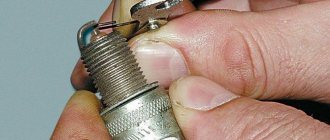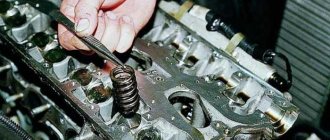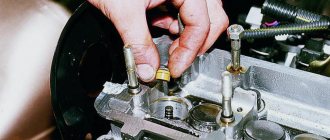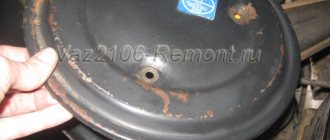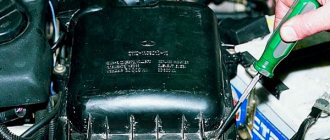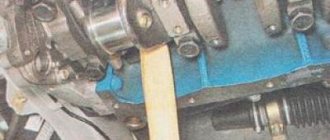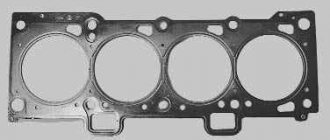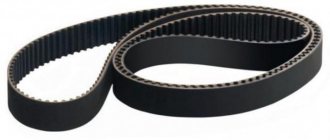Valve seals (VSE) isolate the internal combustion engine from excess lubricant. They are made from a special type of rubber that can withstand loads. However, over time they still wear out, so excess oil gets inside the power plant. This leads to increased vehicle consumption and other problems. Find out how to replace valve stem seals yourself.
Reasons for replacing caps
On average, oil seals last 100 thousand kilometers or more. But this indicator is average; in fact, it all depends on the characteristic features:
- sealing failures - oil consumption increases sharply for every 1000 km;
- changes in the color of the exhaust - when starting or braking, gray, bluish smoke pours out of the muffler;
- coking of spark plugs.
At least one of the listed symptoms will indicate the need for a thorough check and, if necessary, replacement of the valve stem seals.
Do additives help with valve seal leaks?
In the long line of magical products for non-contact engine repair, there are also additives that supposedly eliminate leaks through seals. The principle of operation is clearly explained - they soften the rubber of oil seals or gaskets, restoring their volume and elasticity. If you don’t think any further and buy right away, then that’s enough.
In fact, you have to examine what the deception is in each specific case. If we are talking about MSCs, then their material is such (described above about temperature conditions) that no solvents or ethers that make up the essence of the additives will affect it. Moreover, they will not restore the worn edge and tighten the ring spring.
If you are too lazy to repair it or there are more objective reasons, then there is nothing wrong with stiffened caps. You can drive for a while, especially if the catalyst has been removed from the car.
Then you still have to repair the engine; the valve seal is far from the only part that fails. And when doing repairs, it’s better to buy good products from a reliable manufacturer than to spend the same money on additives, it’s known for whom they were invented.
Replacing caps without removing the cylinder head (Instructions + link to Video)
A special lift is not needed to replace caps in a garage. Below is more information on how to carry out work on a 16-valve 1.8 liter engine. At the same time as this procedure, it is recommended to replace the timing belt, tension/idler rollers, pump and antifreeze so as not to disassemble the car again.
- Unscrew and remove the ignition coil module. On some cars, just pull out the spark plugs.
- Disconnect battery. It is enough to remove the negative terminal.
- Disconnect the electronic control unit to remove the multi-core cable and provide access to the left side of the internal combustion engine and the gas distribution mechanism.
- Remove attachments that interfere with removal of the timing belt.
- Remove the timing belt or chain.
- Release the camshaft gears using a camshaft holder and a socket with an extension. Then you need to remove the plastic protective cover.
- Disconnect unnecessary lines (crankcase exhaust hose, fuel hose, etc.).
- Unscrew the valve covers. It is easier to remove the valve cover bolts with a special pipe wrench or socket.
- Unscrew the camshaft bed fastenings using a Torx hexagon.
- Pull out the beds. Here you need a pry bar, which is inserted into the gap and helps to unstick the stock from the sealant.
- Remove all hydraulic compensators using a magnet. Be sure to sign each pusher so that it is inserted into its original place.
Now all that remains is to remove the MSC.
Video: Replacing valve stem seals without removing the cylinder head
What is a car's timing belt?
The smooth functioning of the gas distribution mechanism is very important for the smooth operation of the internal combustion engine. The timing belt supplies the combustible mixture to the cylinders and removes exhaust gases from the combustion chamber.
Timely gas distribution is ensured by the movement of the intake and exhaust valves by transferring force to them from the camshaft through cams. In modern car models, the gas distribution mechanism also affects the power and environmental friendliness of the internal combustion engine.
Removing the caps
The work is carried out as follows:
- screw a homemade fitting into the spark plug well;
- connect the compressor, creating pressure in the cylinder - due to the increased pressure in the cylinder, the valve will not fall;
- put the desiccant on, lightly tap it with a hammer and remove the spring with the cracker (we use a magnet again);
- Pull out the oil seal using pliers.
New oil seals are inserted quietly onto the valve, which does not go down, since it is held in place by the pressure from below from the operating compressor. After installing the MSC (you can take the oil seal with tweezers for convenience), you need to press it with a spacer and lightly tap it with a hammer. Replace the spring and dry it. This is how the valve stem seals are replaced without removing the head.
Attention! Before installing a new oil seal, you should install a homemade threader on the valve. A piece of threaded candle will do. It is needed so that the rubber part of the MSC does not lift up during installation. After inserting the oil seal, the homemade element is pulled out.
Necessary tool
Be sure to prepare:
- valve desiccant with nozzles (goat);
- special pliers for removing caps;
- magnet on telescopic antenna;
- hammer;
- tweezers;
- Torx-type hex key;
- shaft holder;
- aluminum tube for pressing in new oil seals;
- a homemade fitting made from a candle - a fitting is welded to one end for threading the compressor hose;
- homemade threader for inserting new MSCs;
- pump (compressor).
And of course, we prepare new consumables: oil seals, valve cover gaskets, belts, rollers, etc.
Required tools and materials
Self-replacement will require a special tool. The main specific device is a valve desiccant. You will need it to replace the valve seal. Devices and materials:
- sets of socket and socket wrenches;
- extension cord with heads;
- rod and hammer;
- Collet clamp;
- press frame;
- tweezers;
- head gasket;
- a set of new caps;
- sealant.
During the work, it is possible to replace the gaskets under the block and cylinder head. New oil seals are selected for a specific engine model.
This is interesting: Work and rest schedule for drivers: basic legal provisions for 2022
What are the best replacement caps to buy?
MSCs are necessary to seal the gaps between the valve and the guides. For this reason, their quality must be high, otherwise they will quickly wear out and oil will begin to enter the combustion chamber. The best oil seal manufacturers are presented below.
- Nok. The Japanese manufacturer produces high-quality original oil seals, mainly for Toyota and Honda. There are also products for the aftermarket. The service life of these MSKs is guaranteed for 2-3 years or 50 thousand km of vehicle mileage.
- Elring. A German brand that produces excellent products. Oil seals of this form are characterized by elasticity and reliability. True, a number of series were released with inaccurate dimensions, but the manufacturer attributed this to fakes.
- Victor. An American-German holding company that makes very good valve stem seals. Advantages: efficient oil removal, large assortment, originality. The disadvantage is the high price.
It is advisable to replace oil scraper elements at 100-150 thousand km on domestic cars and 200-250 thousand km on foreign cars (Mercedes, Toyota, BMW). And be sure to monitor the signs - oil consumption has increased, you need to check and draw conclusions. The price for replacing valve stem seals without removing the cylinder head at a service station is from 200 to 1000 rubles per set.
Useful tips
Valve seal kits vary in design for different engines. Installation is carried out in accordance with technical recommendations for a specific car model. When carrying out work yourself, be careful:
- matching diameters of the bushing belt and the valve stem;
- lengths of the guide bushing and cap seats;
- oil installations with reliable fixation (without the slightest backlash);
- selecting a set of caps for a specific engine model.
A high class of precision in the manufacture of parts allows for increased joint density and complete matching of dimensions.
Additives for restoring oil seals are available on the market. Their operating principle is to soften the hardened rubber of the o-ring. Manufacturers differ in the quality of their additives. There are different effects on rubber: no effect or excessive softening, which leads to excessive oil consumption.
When replacing without a collet, proceed with caution. The seat ring is thin and fragile. Replacing with pliers may damage the bushing step. Subsequent repairs to the seat and valve are more expensive than purchasing tools and a new set of seals.
Consequences of driving with worn valve stem seals
Of course, it will be possible to drive with worn valve stem seals for some time. But if the driver ignores the signs listed above, he will worsen the condition of the unit to such an extent that it will eventually exhaust its service life without even completing the required mileage.


